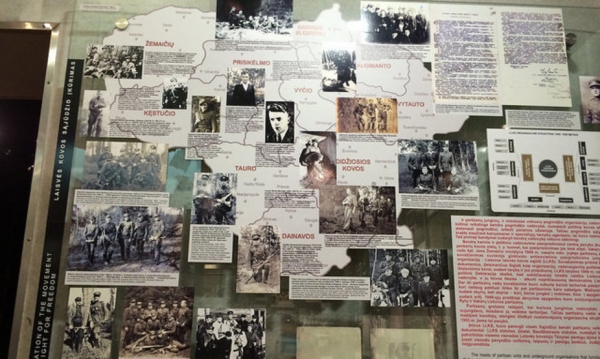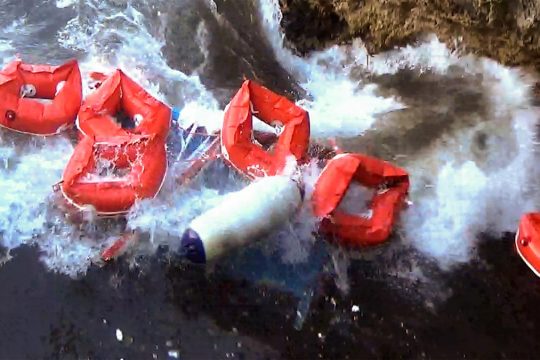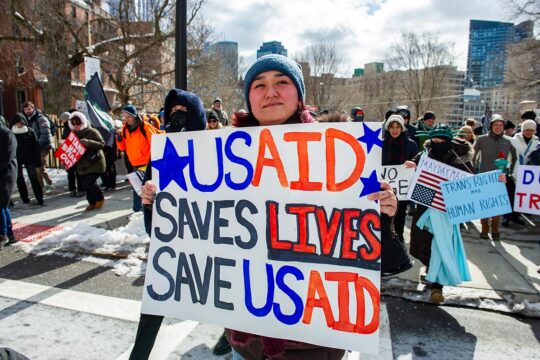The Baltic States of Lithuania, Latvia and Estonia were occupied by both the former Soviet Union and Nazi Germany. Massive crimes against opponents and minorities were committed under both regimes, but Soviet crimes tend to overshadow the Holocaust in current national remembrance.
This article is co-published with theconversation.com
On Gediminas Avenue, the main street of Vilnius, is an impressive white building. This is the former headquarters of the KGB, which from 1941 à 1943 also housed the Gestapo. Names are engraved on the façade along with dates of births and deaths, almost all of which happened between 1944 and the early 1950s, in other words, the years of Stalinist repression. This building houses the Museum of Genocide Victims. It is an official museum dedicated to the violence perpetrated against the nationalists and intelligentsia of Lithuania. These crimes are categorized here as genocide, although that is far from the judicial definition and from historical consensus. The management of the museum declined to answer our questions, despite repeated requests.
In Vilnius, “resistance” was against the Soviets
The first room on the ground floor is dedicated to the German-Soviet Ribbentrop-Molotov pact of 1939, after which the USSR invaded Lithuania, cracked down and deported the intelligentsia. Then the second and following rooms describe the continuation of Communist crimes after the Red Army chased out the Nazi forces, deportations to the Gulag and KGB activities up to when independence was regained in 1991. The “resistance fighters” and “partisans” glorified here refer to those who fought against the Soviets, but not against the Nazis. The central narrative of the Museum of Genocide Victims is the 21,500 Lithuanians killed by the Soviets between 1940-1941 and 1944-1990, and the 50,000 others who died in detention or deportation, according the museum’s statistics.
It is only at the bottom of a plaque in the second room that there is a one-line mention of the 200,000 Jews (96% of the Jews living in the country) exterminated by the Nazis. And it is only in the basement of the museum that one of some 20 KGB cells has – only a few years ago and under international pressure – been reorganized to commemorate the extermination of the Jews. The responsibility of Lithuanian collaborators is thus evoked in timid terms: “the Nazis managed to involve some of the local residents”.
A few streets away, the narrative is very different at the little Holocaust Museum, a tiny green house at the end of an alleyway. This museum, initially set up by survivors, exhibits in a few small rooms a profusion of photos and testimonies on the destruction of the Jews by the Nazis and their Lithuanian accomplices. It is done in very different terms from the euphemisms of the Museum of Genocide Victims. On one wall, a map shows the massacres committed all across the country. Lithuania was an immense cemetery for the Jews. “This is a subject that people are only just starting to talk about,” explains Irina Pociene of the Centre for Tolerance in Vilnius.
Occupation in the singular
The Latvian capital Riga also has a Museum of the Occupation, housed in a temporary building on the edge of the old town. Occupation in the singular, which alludes to the Soviet occupation, even though the country was also under the Nazis from 1941-1944. The German occupation is nevertheless talked about in the permanent exhibition. A big panel reflects the work of the Commission of the Historians of Latvia who tackled frankly the crimes committed by both the Soviets and the Nazis. Latvian emigrants in the USA provide most of the funding for the museum, even if the Latvian State also participates significantly, since it funds all the operating costs.
Museum director Gunars Nagels, a Latvian of Australian origin, explains his fight to enlarge and modernize his museum but says he is up against “political obstacles”. The municipality is governed by “Harmony”, a political party in which the Russian minority (25.8% of the population in the country and much more in urban areas) is strongly represented. “For the Russians, getting rid of the Nazis was liberation, whereas for the Latvians it meant they went from one occupation to another,” explains Gunars Nagels. One photo shows a joyous crowd welcoming German soldiers to Riga in 1940 and hoping to regain their independence, which only happened 1991. “Many Russians do not like that the museum also talks about the decades of Soviet occupation, and many Latvians do not like either that it mentions the responsibility of some of them in the deaths of 50,000 Jewish fellow citizens,” he says.
Gunars Nagels questions comparison of Soviet and Nazi crimes in these terms: “If a murderer kills 12 people and another kills 10, is the second one any less of a murderer?” This point of view can be explained by the specific history of the Baltic countries, which is different from what Western Europe lived through. To better reinforce his words, the director offers visitors the badge of the “Black Ribbon”, which since 2009 commemorates every August 23 the European Day of Remembrance for Victims of Stalinism and Nazism.
In Tallinn, a Museum of Occupations… and freedom
Unlike in Vilnius and Riga, the Museum of Occupations (this time with an “s”) in Tallinn does not claim to be the custodian of the official truth. The museum, which is funded by Estonians in the United States, aims to be a museum of civil society. The country’s collaboration with Nazi Germany is not skirted around as in Vilnius. Films and photos show how soldiers of the Third Reich were welcomed as liberators by the population, even how Estonians fought as “heroes” in the Wehrmacht to try and push back the Soviets in 1943. It is also true that the country’s past linked to extermination of Jews is less heavy: 3,000 of its 4,000 Jews survived in Sweden or the USSR.
In February 2016, the museum announced plans to renovate and rename itself the Museum of Freedom. Faced with resistance from some of the older generation of Estonians who do not want their victim status downplayed – all the more so because a planned memorial to Communist crimes has yet to be built –, a compromise was found: the museum is to be called the Museum of Occupations and Freedom. Merilin Piipuu, director of the museum, explains:
“Thanks to its independence, the museum of Tallin is able to evolve rapidly and adapt its way of presenting things to contemporary narratives. It wants to be forward-looking and target primarily the youth, by questioning the concept of freedom in Estonia today. How would today’s youth have reacted to the occupations of the past? What price would they have been prepared to pay for this freedom?”
The spectre of Crimea
Such questions are all the more relevant in a region where Soviet crimes, and also those committed against the Jews, are seen in the light of current geopolitical stakes. Since 2004, the three Baltic countries have been members of NATO, joined the European Union and adopted the Euro, but they all fear today that they might suffer the same fate as Crimea.
They also face a major conundrum: how to reconcile their national unity, built on the memory of Soviet crimes, with the presence of big Russian minorities? Given the complexity of a past which is still so present, the director states the museum’s challenges thus:
“We want to link the issues of past tragedies with issues of human rights and freedom. But the fragility of our freedom becomes even more apparent when we see the unpredictable behaviour of our big Russian neighbour…”






